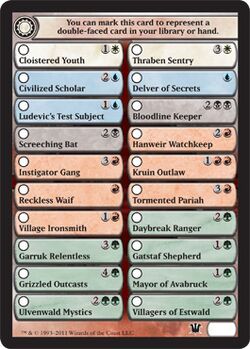Double-faced card: Difference between revisions
>Unistardust (Comprehensive Rules) |
>Hunterofsalvation No edit summary |
||
| Line 1: | Line 1: | ||
[[Image:InnistradChecklist.jpg|thumb|right|250px|''[[Innistrad]]'' [[Double-faced cards]] checklist]] | [[Image:InnistradChecklist.jpg|thumb|right|250px|''[[Innistrad]]'' [[Double-faced cards]] checklist]] | ||
'''Double-faced Cards''' were first introduced in '''''Magic''''' with the set ''[[Innistrad]]'' and represent a radical change for the [[Card frame]]. Until their release, no legal card could have a different print on the back than the regular Magic card back. However, double-faced cards have a regular card frame on each side. In ''Innistrad'' there are 2 [[white]], 3 [[blue]], 2 [[black]], 6 [[red]] and 7 green double-faced cards. | '''Double-faced Cards''' were first introduced in '''''Magic''''' with the set ''[[Innistrad]]'' and represent a radical change for the [[Card frame]]. Until their release, no legal card could have a different print on the back than the regular Magic [[card back]]. However, double-faced cards have a regular card frame on each side. In ''Innistrad'' there are 2 [[white]], 3 [[blue]], 2 [[black]], 6 [[red]] and 7 green double-faced cards. | ||
{{CR|Innistrad|*'''711.''' Double-Faced Cards | {{CR|Innistrad|*'''711.''' Double-Faced Cards | ||
Revision as of 08:43, 21 May 2012

Double-faced Cards were first introduced in Magic with the set Innistrad and represent a radical change for the Card frame. Until their release, no legal card could have a different print on the back than the regular Magic card back. However, double-faced cards have a regular card frame on each side. In Innistrad there are 2 white, 3 blue, 2 black, 6 red and 7 green double-faced cards.
Lua error in Module:CR at line 549: Unknown error, multiple lookups .
Playing with double-sided cards
Double-faced cards have an icon next to the name representing a sun or a moon. The front of the card is called the day side and has a regular card frame and has the sun symbol. The night side has the moon symbol and a slightly altered frame similar to Planeshifted cards with a darker textbox and white text for the card type, name, and Power/Toughness.
Double-sided cards enter the battlefield with their day side. To switch between the two card faces, the keyword action transform is used. During transformation, all counters, Auras and Equipment stay on the card, and the card neither enters nor leaves the battlefield.
To be allowed to play with double-sided cards, the player must have opaque sleeves for all his cards through which no detail of the cards are visible. If the player has no sleeves or only non-opaque sleeves, the player may use a checklist card which are available with the sets. Checklist cards have the regular magic card back and list all double-faced cards from a set. The player must mark which double-faced card the checklist card is meant to represent on the checklist card, in a manner not visible from the the back of the card. The checklist card is shuffled into the deck while the actual double-faced card is kept outside the game.
Double-faced card Rulings
- Double-faced cards can not be turned face down with cards such as Ixidron. When a double-faced card is instructed to be turned face-down, nothing happens. Similarly, if a non-double-faced card is instructed to transform, nothing happens.
- When a double-sided card is copied, e.g. with a card like Clone, only the characteristics of the face that is currently visible upon copying are copied. Such copies can not transform either.
- If a card is not in play, the only information relevant and viewable for other cards is the day side of the card.
- The color identity of the card includes either face.
Checklist card rulings
- It's important that the cards in your deck be indistinguishable from one another. To accomplish this with double-faced cards, you can use the checklist cards included in some Innistrad booster packs and in the Innistrad fat pack. These checklist cards have a list of all double-faced cards in the Innistrad set on one side and the typical Magic card back on the other side.
- You must have with you the actual double-faced card the checklist card is representing. The double-faced card should be kept apart from the rest of your deck. In tournaments, the double-faced card should also be kept separate from your sideboard.
- A checklist card can't be included in a deck except when it's being used to represent a double-faced card.
- You must mark exactly one fill-in circle on the checklist card to indicate which double-faced card it represents.
- You can still use card sleeves, even if you also choose to use checklist cards.
- During the game, a checklist card is considered to be the double-faced card it represents. For example, say you have a checklist card in your hand representing Tormented Pariah and an opponent casts Despise. The checklist card is a creature card, so your opponent may choose the checklist card and you would discard it.
- As soon as a checklist card enters a public zone (stack, battlefield, graveyard, or exile unless it's exiled face down), use the double-faced card and set the checklist card aside. If the double-faced card is put into a hidden zone (hand or library), use the checklist card again.
- If a double-faced card is exiled face down, keep its identity hidden by using the face-down checklist card.